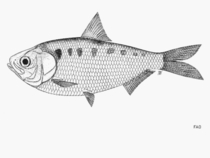Laotian shad
Tenualosa thibaudeaui is a species of fish in the Clupeidae family.
The Laotian shad lives in the pelagic, potamodromous, freshwater environment.
The Laotian shad is classified as Endangered (EN), considered to be facing a very high risk of extinction in the wild.
The Laotian shad occurs in the Mekong River basin, including inland waters of Thailand, Laos, and Cambodia. Most Clupeiformes are not threatened by severe population disruptions, but populations do show natural variability due to fluctuations in reproductive success. More
Laotian shad (Tenualosa thibaudeaui) in former times a very common fish, ... ( Tenualosa thibaudeaui. which is a species endemic to the Mekong. In previous times ... www.mrcmekong. More
Laotian shad (freshwater herring) can be found up to 1,200 miles (2,000 km) upstream from the ocean, but unfortunately it is endangered, with the last known migration occurring in 1984. More
relative of the Laotian shad is the Toli shad ( Tenualosa toli ), which ... www.mrcmekong.org 6 TamilNet: 26.03.09 Ullaik-kazhi / Ullaik-ka'li The zoological terms used for the fish are Tenualosa ilisha or Tenualosa toli. ... More
Common names
Cá Cháy nam in Vietnamese (Tiếng Việt)
Kbork in Khmer (ភាសាខ្មែរ)
Lao shad in English
Laos-stamsild in Danish (dansk)
Laotian shad in English
Mak pang in Lao (ພາສາລາວ)
Mak pang in Laotian
Pa mak pang in English
Pa mak pang in Lao (ພາສາລາວ)
Pa mak pang in Laotian
Pa mak phang in Lao (ພາສາລາວ)
Pa mak phang in Laotian
Pba mak pang in Lao (ພາສາລາວ)
Pba mak pang in Laotian
Tenualosa thibaudeaui in Portuguese (Português)
Trey ca moi in Khmer (ភាសាខ្មែរ)
Trey kabåk in Khmer (ភាសាខ្មែរ)
Trey kbork in Khmer (ភាសាខ្មែរ)
Trey sam lôi in Khmer (ភាសាខ្មែរ)
密鰓鰣(東南亞鰣) in Mandarin Chinese
密鳃鲥(东南亚鲥) in Mandarin Chinese


Original source: FishBase
Permission: Some rights reserved
Family : Clupeidae
Genus : Tenualosa
Species : Tenualosa thibaudeaui
Authority : Durand, 1940
